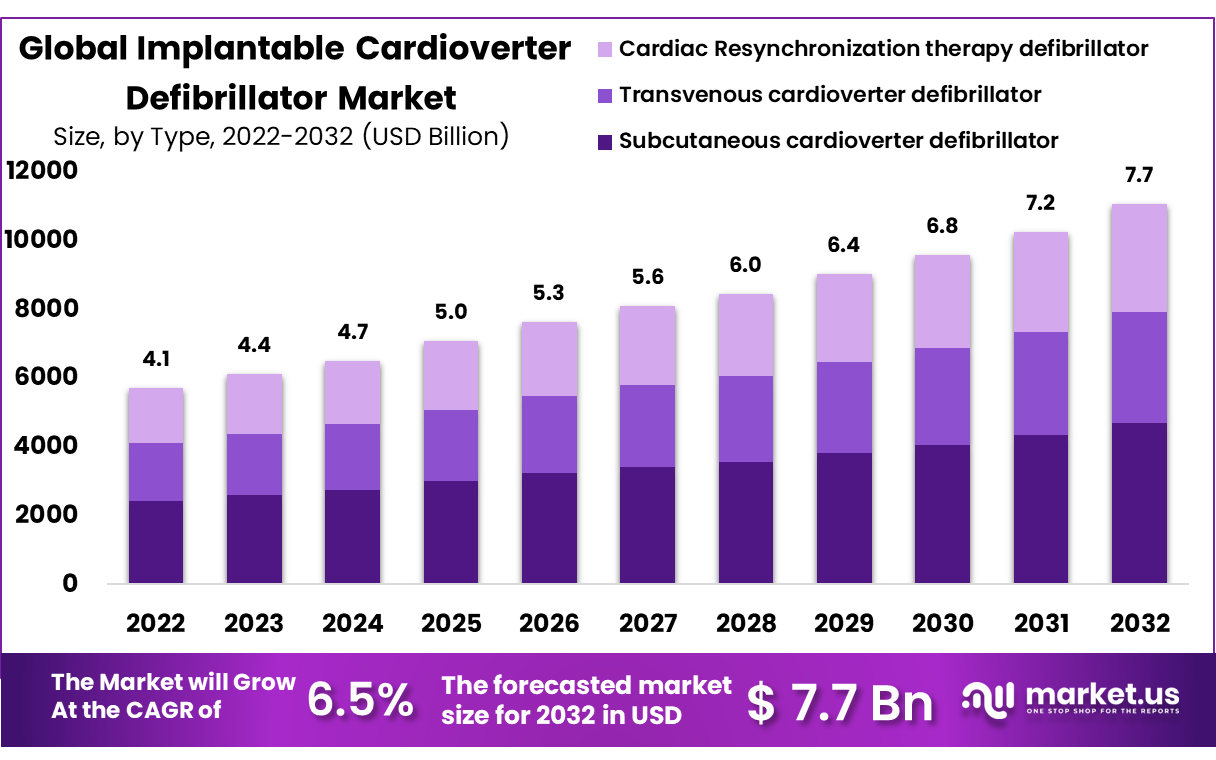Table of Contents
Overview
New York, NY – Aug 26, 2025 – Global Implantable Cardioverter Defibrillator Market size is expected to be worth around USD 7.7 Billion by 2032 from USD 4.7 Billion in 2024, growing at a CAGR of 6.5% during the forecast period from 2025 to 2032.
The Implantable Cardioverter Defibrillator (ICD) has emerged as a critical advancement in the management of life-threatening cardiac arrhythmias. Designed to monitor heart rhythms continuously, the ICD delivers life-saving electrical shocks or pacing therapy when irregularities such as ventricular tachycardia or ventricular fibrillation are detected. This innovative technology significantly reduces the risk of sudden cardiac arrest, which remains a leading cause of mortality worldwide.
The ICD is a small, battery-powered device implanted under the skin, typically below the collarbone. It is connected to the heart through thin insulated wires known as leads. Once in place, the device operates automatically, restoring normal rhythm and offering patients a renewed sense of safety and confidence. Modern ICDs also feature advanced diagnostic capabilities, wireless monitoring, and extended battery life, ensuring improved patient outcomes and reduced hospital visits.
With the rising prevalence of cardiovascular diseases, the adoption of ICDs is expanding globally. Increasing awareness, advancements in minimally invasive procedures, and supportive healthcare policies are driving accessibility to this life-saving therapy.
The introduction of next-generation ICDs represents not only a medical innovation but also a milestone in patient-centric cardiac care. By combining precision, reliability, and continuous monitoring, the ICD continues to transform the landscape of cardiovascular health and improve the quality of life for patients at risk of sudden cardiac death.

Key Takeaways
- An implantable cardioverter defibrillator (ICD) is a medical device used to regulate irregular heartbeats, particularly in patients with chronic arrhythmia.
- Arrhythmia increases the risk of cardiovascular diseases and can lead to heart failure.
- By product type, the subcutaneous implantable cardioverter defibrillator (S-ICD) segment accounts for the largest market share, contributing 42.3%.
- By end user, hospitals represent the leading segment, with the category expected to grow at a CAGR of 49%.
- Geographically, North America dominates the market, holding a 39% share.
- Major industry players include ZOLL Medical Corporation, Boston Scientific Corporation, BIOTRONIK SE & Co. KG, Medtronic PLC, Jude Medical, Koninklijke Philips N.V., Sorin Group, Nihon Kohden Corporation, LivaNova PLC, Fukuda Denshi Co. Ltd., Mediana Co. Ltd., Element Science Inc., and Stryker Corporation, among others.
Regional Analysis
North America accounted for the largest share of the implantable cardioverter defibrillator market, primarily driven by the growing geriatric population and the strong presence of advanced healthcare facilities compared with other regions. These factors have significantly contributed to the rising demand for implantable defibrillators.
The Asia Pacific region is projected to witness substantial growth during the forecast period. This growth is supported by the introduction of advanced technologies offered at affordable prices to patients in low-income areas. Additionally, the increasing prevalence of cardiovascular diseases, largely attributed to poor lifestyle habits such as physical inactivity, unhealthy dietary patterns, smoking, and excessive alcohol consumption, is expected to create opportunities for market expansion.
The rising adoption of implantable cardioverter defibrillators across developing countries, supported by the establishment of modernized hospitals and improved healthcare infrastructure, is anticipated to accelerate revenue growth in the region. Furthermore, the growing demand from Japan is expected to contribute significantly to overall market growth in the coming years.
Implantable Cardioverter Defibrillator General Queries Related
- What is an Implantable Cardioverter Defibrillator (ICD)?
-An ICD is a small electronic device implanted in the chest to monitor heart rhythm. It delivers electrical shocks when abnormal heartbeats, such as ventricular tachycardia or fibrillation, are detected, thereby preventing sudden cardiac arrest. - Who requires an Implantable Cardioverter Defibrillator?
-ICDs are recommended for patients at risk of sudden cardiac arrest due to conditions such as heart failure, prior cardiac arrest, inherited arrhythmias, or significantly reduced left ventricular ejection fraction. They are primarily used for high-risk cardiac patients. - What are the risks associated with ICD implantation?
-The procedure carries risks such as infection, bleeding, and device malfunction. In rare cases, inappropriate shocks may occur. However, the clinical benefits of reduced sudden cardiac death often outweigh these risks for eligible patients. - What is the size of the global Implantable Cardioverter Defibrillator market?
-The global ICD market is valued in billions of dollars and is growing steadily. Growth is driven by rising prevalence of cardiovascular diseases, technological advancements, and increasing adoption of advanced cardiac care solutions worldwide. - Which regions dominate the Implantable Cardioverter Defibrillator market?
-North America holds the largest market share due to advanced healthcare infrastructure and high adoption rates. Europe follows, while Asia-Pacific is expected to witness the fastest growth due to rising healthcare investments and growing patient awareness. - Who are the key players in the ICD market?
-Major companies include Medtronic, Abbott Laboratories, Boston Scientific, and Biotronik. These firms dominate through product innovation, strategic collaborations, and regulatory approvals, ensuring strong competitive positioning in the global ICD landscape.
Conclusion
The Implantable Cardioverter Defibrillator (ICD) has become a cornerstone in modern cardiac care, significantly reducing the risk of sudden cardiac death. Its ability to monitor heart rhythms continuously and deliver life-saving interventions underscores its critical role in managing arrhythmias.
Market growth is being driven by technological innovations, rising cardiovascular disease prevalence, and supportive healthcare policies. North America currently leads adoption, while Asia-Pacific is poised for rapid expansion due to improving healthcare infrastructure and affordability. With increasing demand, robust product innovation, and expanding global accessibility, ICDs will continue to enhance patient outcomes and strengthen the global cardiovascular care landscape.
Discuss your needs with our analyst
Please share your requirements with more details so our analyst can check if they can solve your problem(s)



